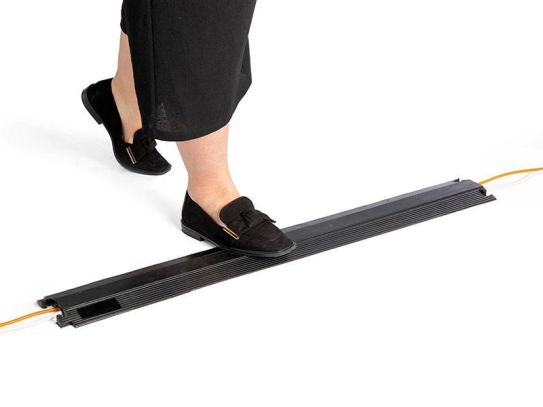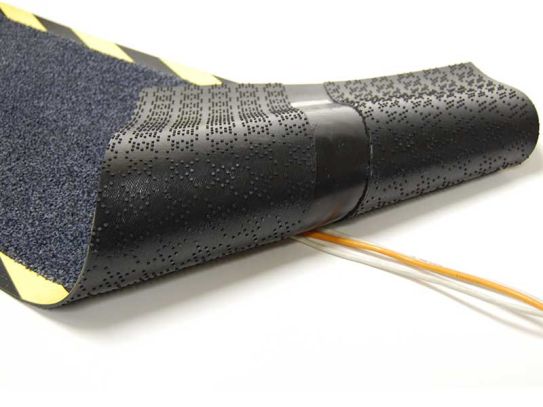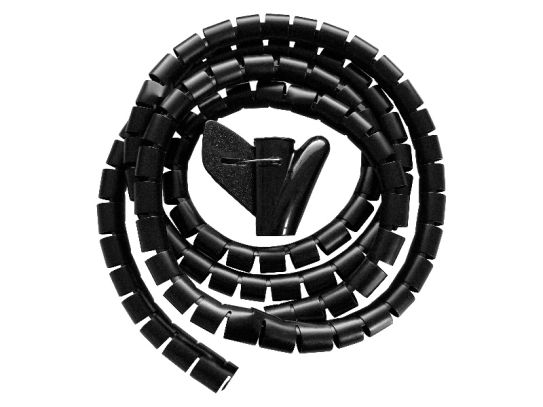Indoor Cable Protectors & Office Cable Covers
Cable Protection, Made Simple
Are you tired of dealing with damaged cables and cords in your home or workspace? Do you want to protect your valuable equipment from the hazards of daily use? Look no further than our range of indoor cable protectors!
Our cable protectors are designed to provide reliable, durable protection for your cables and cords, no matter where you use them. Made from high-quality materials, our protectors are built to withstand the rigours of daily use, protecting your cables from damage caused by foot traffic, furniture, and other potential hazards.
With a range of sizes and styles to choose from, you can find the perfect cable protector for your specific needs. Whether you need to protect a single cable or a whole bundle of cords, we have the cable protection solution you need.
What Is an Indoor Cable Protector?
An indoor cable protector is a protective covering or conduit designed to protect cables and wires that are routed inside a building. These protectors are typically used in environments where cables and wires are exposed to potential physical damage, such as in warehouses, factories, and other industrial settings. Indoor cable protectors are typically made of durable materials such as rubber or plastic and can be designed to fit a variety of cable sizes and configurations. They are often used to protect cables that are in high-traffic areas or in areas where they are at risk of being damaged by heavy equipment or other objects.
What Are Some Common Uses for an Indoor Cable Protector?
Some common uses for an indoor cable protector include protecting cables and wires that are routed through high-traffic areas, protecting cables and wires that are at risk of being damaged by heavy equipment or other objects, and organising and grouping cables and wires in a neat and orderly manner. Indoor cable protectors are commonly used in industrial settings, such as warehouses and factories, but can also be used in other environments, such as offices, schools, and hospitals. In addition to protecting cables and wires, indoor cable protectors can also help to improve safety by reducing the risk of tripping hazards and improving overall cable management.
What Are the Different Types of Indoor Cable Protectors?
There are several different types of indoor cable protectors, including channel protectors, wrap-around protectors, and electrical tape.
- Channel protectors are long, hollow tubes that are designed to hold multiple cables and wires. They are typically made of durable materials such as rubber or plastic and can be used to protect cables and wires in high-traffic areas or in areas where they are at risk of being damaged by heavy equipment or other objects.
- Wrap-around protectors are similar to channel protectors, but instead of a hollow tube, they consist of a flat strip of material that can be wrapped around the cables and wires to provide protection. These protectors are often used in situations where cables and wires need to be routed through tight spaces or around corners.
- Electrical tape is another type of indoor cable protector. It is a type of adhesive tape that is used to insulate electrical wires and prevent them from coming into contact with each other or with other conductive materials. Electrical tape is often used in conjunction with other types of cable protectors to provide additional protection and support.
What Are the Key Features to Consider When Choosing Indoor Cable Protectors?
When choosing indoor cable protectors, there are several key features to consider, including the size and type of cables that need to be protected, the environment where the cables will be used, and the level of protection required.
One important factor to consider is the size and type of cables that need to be protected. Indoor cable protectors are available in a variety of sizes, and it is important to choose a protector that is large enough to accommodate the cables that need to be protected. In addition, some protectors are designed to be used with specific types of cables, such as power cables or data cables, so it is important to choose a protector that is compatible with the cables that will be used.
Another important factor to consider is the environment where the cables will be used. Indoor cable protectors are designed to withstand different levels of wear and tear, so it is important to choose a protector that is suitable for the specific environment where the cables will be used. For example, if the cables will be used in a high-traffic area, it is important to choose a protector that is durable and resistant to damage.
The level of protection required is also an important factor to consider when choosing indoor cable protectors. Some protectors are designed to provide basic protection, while others are designed to provide more robust protection against physical damage. In general, it is important to choose a protector that provides the level of protection needed to ensure the safe and reliable operation of the cables.
How Do I Maintain My Indoor Cable Protector?
There are a few steps you can take to maintain your indoor cable protector and ensure that it continues to provide effective protection for your cables:
- Inspect the cable protector regularly to check for signs of damage or wear. This can include things like cuts, punctures, or other holes in the protective material. If you notice any damage, you should repair or replace the cable protector as needed.
- Keep the cable protector clean and free of debris. This can help to prevent the build-up of dirt and other contaminants that can cause the protective material to break down over time.
- Avoid placing heavy objects on top of the cable protector. This can cause the protective material to become damaged or deformed, reducing its effectiveness.
- Avoid using the cable protector in areas where it may be exposed to excessive heat or moisture. These conditions can cause the protective material to break down more quickly, reducing its lifespan.
- If you need to remove the cable protector for any reason, do so carefully to avoid damaging it. This can help to extend its lifespan and ensure that it continues to provide effective protection for your cables.
Are There Any Special Considerations When Choosing a Cable Protector for a Particular Application?
When choosing an indoor cable protector, there are a few key considerations to keep in mind in order to ensure that you select the right product for your particular environment or application. These may include:
- The type of cables that will be protected: Different cable protectors are designed to work with different types of cables, so you will need to consider the specific cables that you will be protecting in order to choose the right product.
- The environment where the cable protector will be used: The type of cable protector that you choose should be suited to the specific conditions in which it will be used. For example, if the cable protector will be used in a damp or wet environment, you will need to choose a product that is designed to withstand moisture.
- The level of protection that is required: Cable protectors are available in a range of different levels of protection, so you will need to consider the level of protection that is required in your particular application. For example, if you need to protect cables from heavy foot traffic, you will need to choose a product with a higher level of protection.
- The size and shape of the cable protector: Cable protectors are available in a range of different sizes and shapes, so you will need to consider the size and shape of your cables in order to choose the right product.
- The cost of the cable protector: Cable protectors vary in price, so you will need to consider your budget when making your selection. It is important to balance the cost of the cable protector against its effectiveness in protecting your cables.
Are There Any Environmental Benefits Associated with Using an Indoor Cable Protector?
Using an indoor cable protector can provide a number of environmental and sustainability benefits. For example, by protecting cables and cords from damage, a cable protector can help to extend the lifespan of these items. This can reduce the amount of waste generated by replacing damaged cables, which can be beneficial for the environment. In addition, using a cable protector can help to prevent cables from becoming tangled or twisted, which can reduce the amount of energy that is required to operate them. This can help to save energy and reduce greenhouse gas emissions, which is beneficial for the environment and for sustainability. Overall, using an indoor cable protector can be a simple and effective way to help reduce your impact on the environment and support sustainable practices.
Are There Any EU or UK Standards That Affect the Indoor Cable Protector?
There are several European and UK standards that may apply to indoor cable protectors, depending on the specific product and its intended use. These standards are designed to ensure the safety and performance of cable protectors, and may include requirements for things like materials, construction, performance, and labelling. Some of the relevant standards for indoor cable protectors include:
- EN 61537: This European standard specifies requirements for cable protectors used in public and commercial buildings, including requirements for materials, construction, performance, labelling, and testing.
- BS 7671: This British standard sets out the requirements for electrical installations in the UK, including requirements for the protection of cables and cords.
- BS EN 62841-1-1: This European standard specifies requirements for cable protectors used in the entertainment industry, including requirements for materials, construction, performance, labelling, and testing.
- BS 6500: This British standard sets out requirements for the installation and use of electrical equipment in hazardous areas, including requirements for the protection of cables and cords.
It is important to note that these standards are subject to change and may be updated or revised over time. It is always a good idea to check the latest version of any relevant standards before selecting a cable protector for a specific application.




